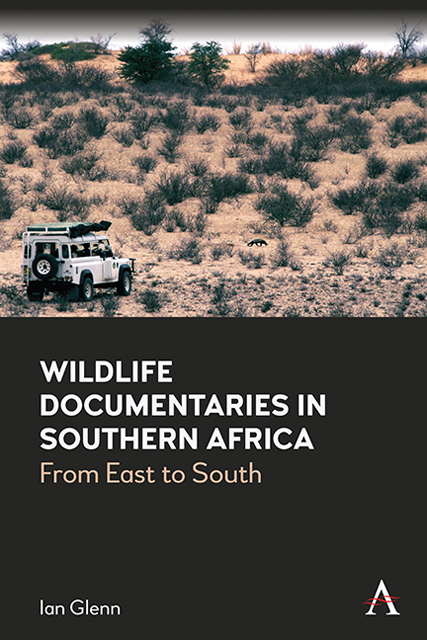Book contents
- Frontmatter
- Dedication
- Contents
- List of Figures
- Acknowledgements
- Introduction
- Chapter 1 What do the Critics Say?
- Chapter 2 A Theoretical Coalition?
- Chapter 3 Gone South: From East to Southern Africa
- Chapter 4 Private Lodges, Infrastructures and Guides
- Chapter 5 Going South: The Results
- Chapter 6 The Early History
- Chapter 7 The South Africans Enter the Game
- Chapter 8 Michael Rosenberg and Partridge Films
- Chapter 9 David and Carol Hughes
- Chapter 10 The Bartletts in the Namib, the Liversedges in Botswana
- Chapter 11 John Varty, Elmon Mhlongo and Londolozi
- Chapter 12 Richard Goss and Kim Wolhuter
- Chapter 13 Dereck and Beverly Joubert
- Chapter 14 Other Major Contributors
- Chapter 15 Going Live: Africam And Wildearth
- Chapter 16 Craig and Damon Foster
- Chapter 17 Must Love Animals?
- Chapter 18 The Social Turn
- Chapter 19 The Future of the Genre
- Chapter 20 The Influence of the Genre
- Conclusion
- Filmography
- Plates
- References
- Index
Chapter 14 - Other Major Contributors
Published online by Cambridge University Press: 10 January 2023
- Frontmatter
- Dedication
- Contents
- List of Figures
- Acknowledgements
- Introduction
- Chapter 1 What do the Critics Say?
- Chapter 2 A Theoretical Coalition?
- Chapter 3 Gone South: From East to Southern Africa
- Chapter 4 Private Lodges, Infrastructures and Guides
- Chapter 5 Going South: The Results
- Chapter 6 The Early History
- Chapter 7 The South Africans Enter the Game
- Chapter 8 Michael Rosenberg and Partridge Films
- Chapter 9 David and Carol Hughes
- Chapter 10 The Bartletts in the Namib, the Liversedges in Botswana
- Chapter 11 John Varty, Elmon Mhlongo and Londolozi
- Chapter 12 Richard Goss and Kim Wolhuter
- Chapter 13 Dereck and Beverly Joubert
- Chapter 14 Other Major Contributors
- Chapter 15 Going Live: Africam And Wildearth
- Chapter 16 Craig and Damon Foster
- Chapter 17 Must Love Animals?
- Chapter 18 The Social Turn
- Chapter 19 The Future of the Genre
- Chapter 20 The Influence of the Genre
- Conclusion
- Filmography
- Plates
- References
- Index
Summary
There are many other excellent filmmakers who have worked in Southern Africa in the past 50 years who in a longer book would get closer examination. In many ways, they fit the paradigms already established: many of them worked with Mike Rosenberg and Partridge; they spend lengthy time in one place; they establish striking bonds with individual animals; they come from a guiding culture and use that expertise in their films; they break away from the NHU model; they break into the US and British markets. Perhaps unfairly, I have omitted not only important local programmes such as 50/50 that probably were the main domestic environmental and wildlife viewing for most South Africans but also other important figures such as Richard Matthews and Michael Holding who seem to me to belong to rather different schools and traditions.
Keith and Colleen Begg
After completing their double-headed achievement of four years’ work on honey badgers in the Kalahari with the Hugheses, from which Colleen Begg emerged with a PhD and Keith with an important supporting part in an influential film, they did and do important advocacy work. Keith worked on the conflict between commercial beekeepers and honey badgers for the Endangered Wildlife Trust’s Carnivore Conservation Group and since 2003, the couple have been working in northern Mozambique in the remote Niassa National Reserve. They studied badgers here and produced another film called Badger Quest: Honey hunters of Niassa (2008) which examines not only the honey badgers but how local people use honeyguide birds to locate hives. Their interest in the traditional relationships of the local Cyao people with nature led to Spirit Creatures: Niassa’s Invisible Realm (2104).
At present they are managing the Niassa Carnivore Project which aims to secure lions and other carnivores in Niassa Reserve by promoting coexistence between lions and people while navigating the complex political situation in an area where something close to civil war is raging. What emerges from this filmmaker–scientist partnership is that conservation work and the recording of that work may be one way of couples not collaborating simply on a film but on a larger social and environmental project.
- Type
- Chapter
- Information
- Wildlife Documentaries in Southern AfricaFrom East to South, pp. 187 - 194Publisher: Anthem PressPrint publication year: 2022

